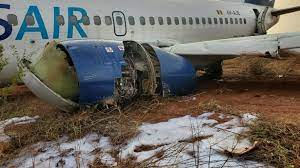The Incident
In a devastating turn of events, a Boeing 737-300 aircraft crashed during takeoff at Senegal’s Blaise Diagne International Airport. The tragic incident unfolded in the early hours of Thursday, sending shockwaves through the aviation community.
Flight HC301: The Details
The ill-fated flight, identified as Air Senegal flight HC301 and operated by Transair, encountered a catastrophic failure as it attempted to depart. According to statements from Senegal’s Ministry of Infrastructure, Land, and Air Transport, the aircraft “overran the runway,” leading to the fatal crash.
Casualties and Crew
Onboard the flight were a total of 78 individuals, including passengers and crew members. Among them were two pilots and four cabin crew members. The grim toll of the crash underscores the magnitude of the tragedy and the profound loss experienced by the victims’ families and loved ones.
Investigation and Response
Following the crash, authorities swiftly launched investigations to determine the cause of the accident. As rescue and recovery efforts commenced at the crash site, the global aviation community mourned the loss and awaited answers regarding the circumstances surrounding the tragic event.
Lessons Learned
The Boeing 737-300 crash serves as a stark reminder of the inherent risks associated with air travel and the critical importance of safety protocols and regulatory oversight. It underscores the need for continual vigilance and proactive measures to prevent similar tragedies in the future.
As the investigation unfolds and the aviation community grapples with the aftermath of the Boeing 737-300 crash, our thoughts remain with the victims and their families. May their memories be honored, and may this tragedy serve as a catalyst for ongoing efforts to enhance aviation safety worldwide.




